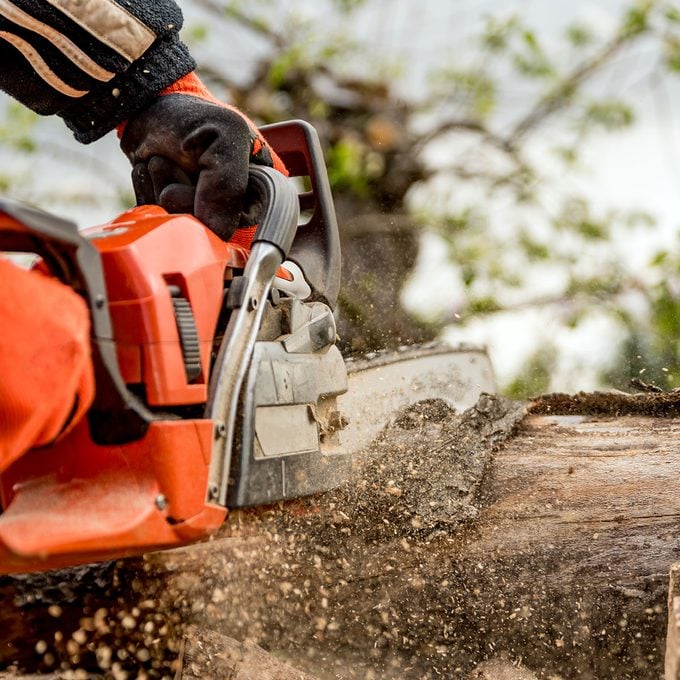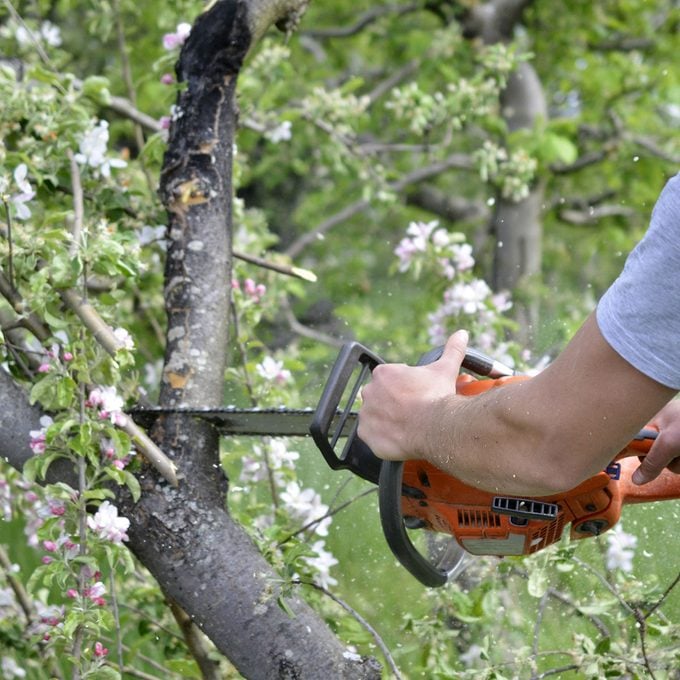Everything to Consider When Buying a Chainsaw
Updated: Jul. 20, 2023

The wide variety of chainsaw models can make choosing one difficult. Here's an overview of the various options for the DIY buyer.
Our editors and experts handpick every product we feature. We may earn a commission from your purchases.Learn more.
A chainsaw is a powerful tool that can save countless hours of manual labor. If you’re in the market for a chainsaw, it’s vital to factor in chainsaw safety, budget and user experience to make sure you’re choosing the perfect tool for you.
On This Page
What Is a Chainsaw?
A chainsaw is a portable saw that cuts with a set of teeth on a continuous chain that rotates over and around a guide bar. While the basic concept of a chainsaw has been adapted for use in everything from surgery to carpentry, the term is mostly used for tools intended for activities such as tree trimming and felling, which is what we’ll be focusing on.
Types of Chainsaws
A standard chainsaw is what most people think of when they hear “chainsaw.” Although their design may seem similar, there are different handheld chainsaws made for everything from felling large trees to lightweight yard maintenance.
A pole saw allows the user to trim limbs that would ordinarily be out of reach. The simplest description of a pole saw? A saw mounted on a long stick. They can be gas- or electric-powered, although many homeowners prefer corded models to keep the saw as light as possible. Controls for the saw are at the base of the pole, enabling the user to safely turn them on or off from the ground. Some pole saws are detachable from their pole, allowing them to be used as lightweight saws around the yard.
An enclosed saw shields the user entirely from the moving chain. Relatively small and lightweight, these are most frequently electric-powered limb trimmers.
P.S. If you struggle with bulky power tools, you might want to check out the Saker mini chainsaw.

Chainsaw Power Options
Gas-powered chainsaws are the most powerful option, and can drive the longest bar length. This means that they can bring down larger trees and work faster with less wear on the chain. Gas-powered saws are noisier and heavier than electric models, and their engine requires more maintenance. Also, most gas-powered chainsaws run on a blend of gasoline and 2-cycle oil — the exact ratio depending on the manufacturer — so you’ll need to make your own or keep pre-mixed fuel on hand.
Electric chainsaws are available in corded or battery-powered varieties. They have less power than gas-powered chainsaws. A corded saw has as much power as a mid-range gas saw, while battery-operated chainsaws tend to have even less power.
Naturally, the biggest limitation on a corded saw is the length of the cord. Be sure to pay attention to the amps that your corded chainsaw draws, as you’ll need an extension cord that can handle that load. Look for the amperage rating on your extension cord, and if in doubt, pick up a new heavy-duty cord when you buy your saw. Battery-powered chainsaws work great on smaller jobs or occasional maintenance.
You may also find some pneumatic chainsaws that run on compressed air. Seen much less frequently than gas or electric models, pneumatic chainsaws have many of the same pros and cons as corded chainsaws, with one added complication — you may need to purchase an air compressor to use it.
Chainsaw Features
There are many features available on chainsaws, more than we can describe in this piece. Here are some key features to look for.
Chain type: Most DIYers will be fine using the chain that comes with their chainsaw. However, if you find yourself using your chainsaw for wide-ranging tasks, familiarize yourself with the teeth profile and spacing options available. If you think you’ll need multiple chains, be certain the chainsaw you choose makes exchanging the chain easy.
Handle Position: Top-handle saws are more compact and lighter, and can often be used one-handed. But they are designed for use at height, which sacrifices stability.
If you’ll be working on the ground, their maneuverability makes them a great choice for pruning limbs and fallen branches. If you’ll be taking down trees or working with large logs on the ground, it’s probably wiser to choose a rear-handle model with a wider handgrip for more protection against kickback.
Anti-vibration: To reduce fatigue, look for a chainsaw with rubberized handles and anti-vibration features. This is particularly useful on gas-powered saws, which have more vibration due to the moving parts of the engine.
Chain Brake: In case of kickback, a chain brake stops the motion of the chain almost immediately, making it a great safety feature.
Chainsaw Buying Considerations and Cost
A typical homeowner should expect to spend between $100 to $500 for a chainsaw. There are plenty of saws on the market that cost far more, but they are primarily aimed at professionals who use these tools all day and depend on them for their lives and livelihood.
For DIYers, the primary consideration is power and usage. A more powerful saw will require a gas motor, while a less powerful, more mobile one can be driven by an electric motor. If you’ll be clearing trees from your property and converting them into firewood, then you’ll be well served to get an 18- to 24-in. bar and a gas-powered chainsaw. If you’re simply trimming the occasional limb or fallen branch, you’ll be better off with a shorter bar and a corded or battery-powered saw.

Chainsaw Maintenance and Repair Considerations
The maintenance of chainsaws primarily involves the chain and the motor.
Keep the chain and bar free of debris such as dirt or twigs, maintain proper chain tension and maintain the chain oil. All are easy to do yourself and should be done on a regular basis, preferably after each significant use.
Sharpen the chain as often as needed; this will vary depending on the frequency and nature of use, but a general rule do so every time you refill the gas tank. (For electric models, sharpen after a full day’s use.) No matter what kind of saw you have, if you find it’s taking longer or requiring pressure to cut, it’s time to sharpen the chain on your saw. If you choose to do your own sharpening, you can do it manually or with a rotary tool. If you’d rather leave it to a pro, take the saw to a lawnmower service center or blade sharpener shop.
For a gas-powered engine, you’ll need to clear the air filter and tune up the engine from time to time. During the off-season run the engine until there’s no gas, clean and oil the whole tool, then store it somewhere dry. Electric chainsaws should be wiped down after each use to prevent rust or clogging, but overall they have fewer engine concerns than their gas-powered counterparts.
General chainsaw maintenance can be totally DIY or as part of your annual lawn tool check-up. Most lawnmower service centers also take chainsaws, so you can drop them off together.



















